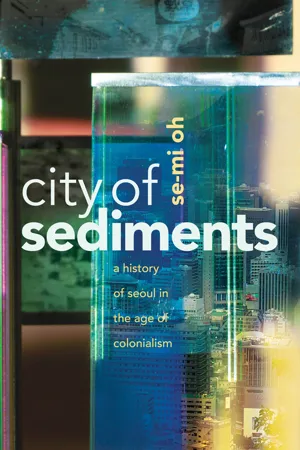
- 280 pages
- English
- ePUB (mobile friendly)
- Available on iOS & Android
About this book
Once the capital of the five-hundred-year Chos?n dynasty (1392–1897) and the Taehan Empire (1897–1910), the city of Seoul posed unique challenges to urban reform and modernization under Japanese colonial rule in the early twentieth century, constrained by the labyrinthian built environment of the old Korean capital. Colonial authorities attempted to employ a strategy of "erasure"—monumental Japanese architecture was, for instance, superimposed upon existing palace structures—to articulate to colonized Korean subjects the transition from the pre-modern to the modern, and the naturalization of colonial rule as inevitable historical change.
Drawing from and analyzing a wide range of materials, from architecture and photography to print media and sound recordings, City of Sediments shows how Seoul became a site to articulate a new mode of time—modernity—that defined the place of the colonized in accordance with the progression of history, and how the underbelly of the city, latent places of darkness filled with chatters of the alleyway, challenged this visual language of power. To do so, Se-Mi Oh builds an inventive new model of history where discrete events do not unfold one after the other, but rather one in which histories layer atop each other like sediment, allowing a new map of colonial Seoul to emerge, a map where the material traces of the city are overlapping, with vibrant residues of earlier times defiantly visible among the superimposed signs of modernity and colonial domination.
Frequently asked questions
- Essential is ideal for learners and professionals who enjoy exploring a wide range of subjects. Access the Essential Library with 800,000+ trusted titles and best-sellers across business, personal growth, and the humanities. Includes unlimited reading time and Standard Read Aloud voice.
- Complete: Perfect for advanced learners and researchers needing full, unrestricted access. Unlock 1.4M+ books across hundreds of subjects, including academic and specialized titles. The Complete Plan also includes advanced features like Premium Read Aloud and Research Assistant.
Please note we cannot support devices running on iOS 13 and Android 7 or earlier. Learn more about using the app.
Information
Table of contents
- Cover
- Title Page
- Copyright
- Dedication
- Contents
- Notes on Romanization
- List of Illustrations
- Acknowledgments
- Introduction
- Part One: History, Event, the City
- Part Two: Language, Text, Play
- Part Three: Kinetic Optics, Liquid Time
- Epilogue: A Time of Rehearsal
- Notes
- Bibliography
- Index